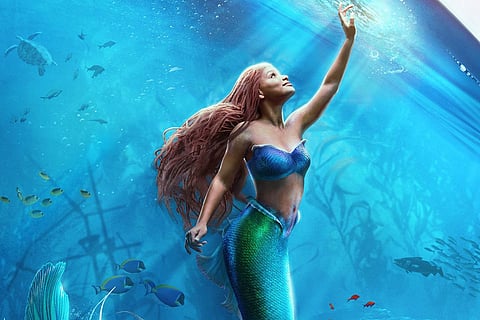

Half-fish and half-woman, the mermaid in fantasy, fairytale, and folklore presents an intriguing idea – that of a sensual yet naive being from another world who is near-human, but animal enough to be exotic. Hans Christian Anderson’s The Little Mermaid, a fairytale first published in the 19th century, has lent itself to multiple interpretations and readings over the years. The mermaid in the original story feels trapped in her body because of her inability to live in the human world. She gives up her voice and embraces pain for the promise of love. Her forlorn figure on the rocks is a haunting image, and it has continued to stay relevant across centuries for this very reason.
Disney’s The Little Mermaid (2023), directed by Rob Marshall, that released in theatres on May 26, is yet another retelling of the original story – and here, the mermaid is played by Halle Bailey, an African-American songwriter, and actor, and there are significant changes in the conclusion of the story too. Not surprisingly, Bailey’s casting as Ariel provoked outrage since the mermaid in the fairytale is white, and Disney’s adaptation was accused of taking ‘woke’ culture too far. This brings us to two important questions: Is adapting a story with major changes the same as censorship? And does representation in popular culture matter to children, who are the primary audience for such content?
Hans Christian Anderson was a white Danish man who described the little mermaid in the following words: “...her skin was as clear and delicate as a rose-leaf, and her eyes as blue as the deepest sea; but, like all the others, she had no feet, and her body ended in a fish’s tail.” The character’s physical description conforms to the beauty ideals of Anderson’s time, in the society and culture that he lived in. The reader he had in mind was likely someone whose beauty ideals would have been the same too. This is neither ‘right’ nor ‘wrong’, and it would be unfair to read the description as evidence of Anderson’s racism or bigotry. He was merely describing attributes that everyone around him agreed were the definition of beauty.
But what happens when these stories achieve a timeless universality? Anderson’s collection of 156 stories, compiled in nine volumes, has been translated into more than 125 languages. Other authors who wrote and compiled fairytales, like the Brothers Grimm or Charles Perrault, have also been widely translated and read across the world, generation after generation.
These stories have remained popular because of the appeal of their themes – many of these tales address deep-rooted fears in the human psyche but also offer hope and redemption.
The Little Mermaid, for example, is a story about exclusion and eventual acceptance. Many have read the story as an acknowledgment of Anderson’s love for another man – Edvard Collin – to whom he wrote several love letters. But even without this knowledge, it’s possible to find oneself in the tortured reflection of the little mermaid. She could be anybody with suppressed dreams and ambitions.
But, quite a few of these stories also reiterate ideas that would be considered archaic and problematic now. For instance, equating beauty with goodness and ugliness with evil or the tendency to portray women as damsels in distress who always need a man to rescue them.
When these stories travel beyond the time period and culture in which they were created, and major studios like Disney convert them into films with powerful visual appeal, it is important to ensure that the adaptation is sensitive in its representation and is relevant to the audience for which it is being made.
Representation in popular culture matters because it helps create and affirm identities, especially for young people. It opens up possibilities and newer ways of looking at the self and the world. However, people with marginalised identities – of gender, race, caste, class, or sexuality – seldom see positive and empathetic representations of their own identity in popular culture. This is only to be expected since those who wield the power and capital to tell these stories tend to be privileged. For instance, Black Panther, America’s first mainstream black superhero, was created in 1966 – about thirty years after the appearance of white superheroes such as the Human Torch, Superman, Captain America, and so on. In 2018, when Marvel released Black Panther, there was a worldwide campaign to send children, particularly of African origin, to watch the film because they rarely got to see such a powerful representation of the black identity otherwise.
Recasting Ariel as a mermaid of African descent allows brown and black children to feel seen. It allows them to imagine themselves in magical stories, a realm where they’re rarely present. Retelling or adapting a story isn’t the same as rewriting it, as was the case with Roald Dahl’s books. Here, one isn’t replacing the original story but finding newer ways to tell it through different perspectives. If anything, a retelling underlines the continued relevance of the original story but offers the reader or viewer fresh takeaways from the narrative.
In 2023, The Little Mermaid is more rebellious and has greater agency than Anderson’s mermaid. She isn’t just lovestruck, she also cares about how easily one community others another. She is more political than her predecessors. She suffers less and values her happiness more. She is of African descent, and her sisters too are of different ancestries. If Anderson’s original intention was to write a story about exclusion, the retelling certainly honours it. It’s the outrage over the new Ariel’s skin colour and identity that doesn’t.
Sowmya Rajendran writes on gender, culture, and cinema. She has written over 25 books, including a nonfiction book on gender for adolescents. She was awarded the Sahitya Akademi’s Bal Sahitya Puraskar for her novel Mayil Will Not Be Quiet in 2015.